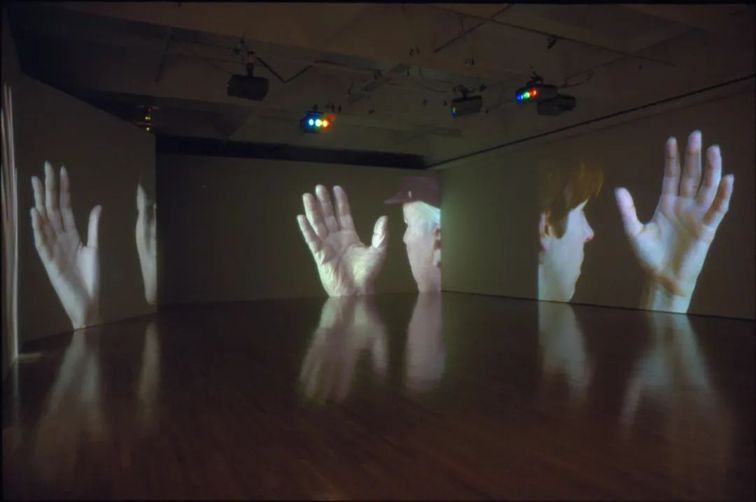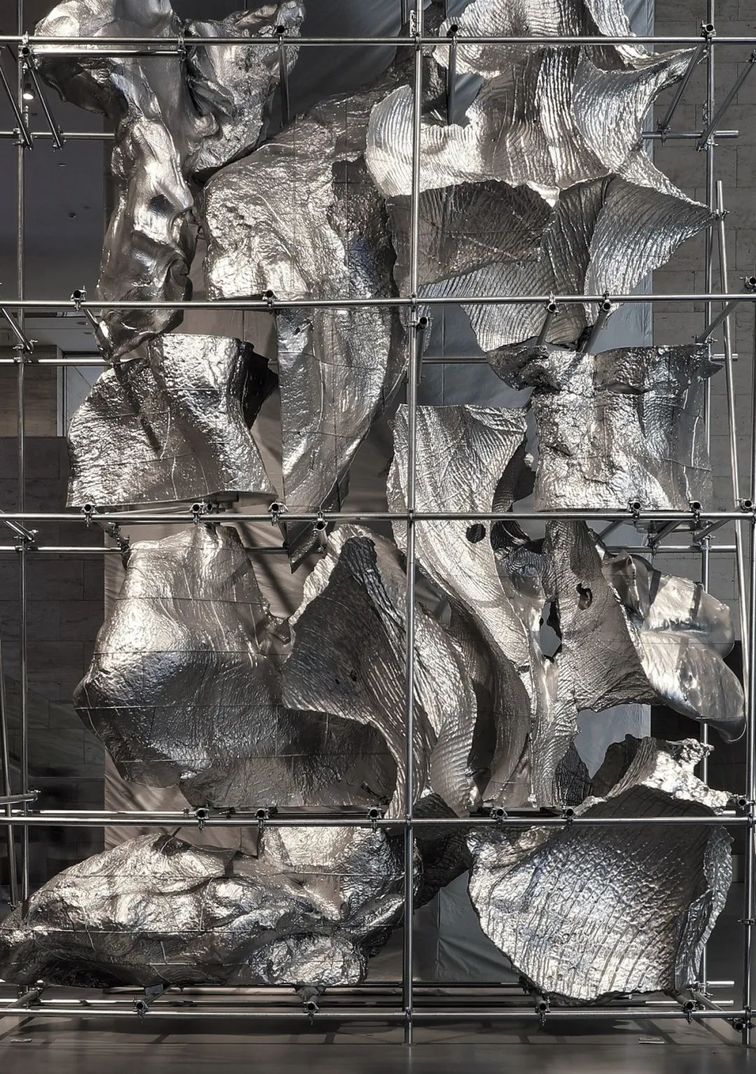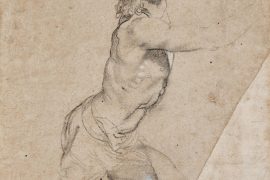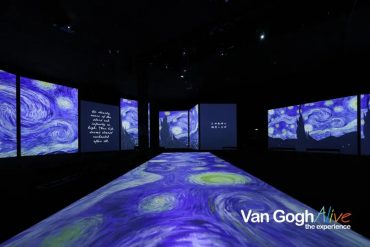This year’s Guangzhou Triennial is themed “Symphony of All the Changes”, with director Wang Shaoqiang (China) as chief curator and Wu Hongliang (China), Philip Dodd (UK), Thomas Eller (Germany) and Jiang Jun (China) as curators. The exhibition is an attempt to open a perspective on a contemporary landscape of changes within changes. Within a historical dimension, “thinking about change”, and the contemporary observation of “changing”, the triennial wants to conceive of a possible “transformation” of the future. The four sections within the curatorial framework reflect on the light of the times and its impact.

Sui Jianguo(China), The Garden in Data Cloud-24Moments, installation, 3D printing photosensitive resin & steel pipe structure, 600cm×400cm×300cm,2022.
A man goes into a gallery to look at wonderful, but very small and intricate ink drawings. He gets closer to see better, but it is not enough. So he rests his thumb and index finger on the drawing to swipe the drawing bigger…
Today it is easy to confuse real life objects with digital objects, because we have become used to handle both simultaneously. We have a smartphone in our hand which has some weight and a smooth touch. With this device we can move a lot of things online, virtually and in real life – sometimes really heavy objects. And the effort for all this is practically the same – the swipe of a finger on a flat glassy surface. We can do this at great distances and in real time. In essence notions of space and time are short-circuited. Of our senses – weight, touch, taste, smell – only two are useful for online interaction: sight and sound.
Thirty-eigth years ago, French philosopher Jean-François Lyotard curated the seminal exhibition entitled “Les Immateriaux” at the Centre Georges Pompidou, Paris (1985). The core argument was that we would be seeing a new order of “matter” emerge that would be shaped by information. And of that matter a new order of objects would be created. What was a utopian idea then, is our reality today.
The section “TOUCH/SCREEN ME” investigates these developments by looking at artists who have, over the course of their careers, been invested in the issues of “matter”, “materiality”, “and materialisms”, topics which are linked to “creation” in both natural and artistic ways. In other words, artists that have made artworks with regard to materiality, both physical and virtual, in mind. This development, we call it digitalization has of course affected all aspects of our lives and the future of our planet. To make the argument short: Digitalization helps humanity to more effectively and more pervasively change nature, using methodologies never been available before. I have long suggested that digitalization to human development is as significant, as was the invention of fire. We have just entered a phase that will profoundly change what we know of “nature” and us humans in it. Of course, humanity has changed nature as long as it has existed. However, there is a reversal in direction. For the most part, we had to learn how nature works and follow the laws of nature, which took a lot of trial and error. We know the weather before it happens, or, instead of breeding life-stock for a longtime, we can insert wanted characteristics into the organism even from another species altogether – something that nature would never allow otherwise. The difference is in timing. Back in the days, we need to react to what nature told us – now in some respect we can decide, what we want nature to do. What does that mean for the future of our planet and us in it?
By juxtaposing artists from Asia and the West, it will also become clear, that they come from backgrounds of distinctly different material aesthetics. Historically in the West, artists have mainly been working in the public sphere, depicting, and recounting stories and histories of the gods and the worldly powers. Reserving the most precious materials for the most important stories. Literati culture in China has instead taught to regard the humblest subjects with the highest respect. Here is an example for clarity.
Benvenuto Cellini in 1540-43 made his famous “Saliera” (an object to put salt in for big banquets) for King François the 1st of France, entirely from gold. It depicts, the god of the seas, Neptune, and the goddess of earth, Tellus. At the time it was the most astonishing piece of craftsmanship in praise of the emperor. The salt trade at the time was an extremely important business. He who controlled salt had power and money. But instead of looking at “salt” the focus was on a cosmological aggrandization of the topic, by applying mythological stories.
By contrast the Chicken cup – they were created during the Ming dynasty (1368 – 1644), during the Chenghua Emperor’s reign (1465 – 1487) in China, and originally functioned as a vessel to drink wine from. Chenghua Chicken Cups were created in an imperial kiln in the Jingdezhen The Emperor Chenghua had the Chicken Cup created in the 15th century as an act of devotion for his empress mother who was recorded to have an appreciation for small objects and valued a simple design taste.
Those are the two perspectives to assume when looking at contemporary art in China and the West: What will happen in the future in terms of cultures of digitalization, which will shape how we will interact with the actual world and what that meant to the planet, our bodies, minds and hearts. It is fair to assume that those existing and coming technologies will have similar impacts on the planet, it´s ecosystems and all of humanity in it. Looking in the other direction, we should learn more about where we respectively come from and learn from the better parts of our respective material cultures and, as recent discussions about New Materialisms would agree, there are very important aspects of material cultures for traditional China to rediscover.
In order to make those rather abstract ideas more tangible, the section TOUCH/SCREEN ME has been divided into four parts.
1. Touch
This context juxtaposes a massive wall piece by Zhang Yu, in which he has repeatedly touched the surface of his paintings applying red ink with his finger, signing it a million times over. This is what an artist does – touching the work towards completion. Much more complex however is the work by Sui Jianguo, whose multi-layered and complex installation “Garden in the Cloud” is a masterpiece that maps out exactly the liminal space between virtual and actual objects. This kind of liminality can be described as a space between two categories that do not mix. Between your finger on the screen and the digital content is no “real” connection, except through that thin glassy surface. Gary Hill, the very important pioneer in media art has been working with that concept for a long time. “HanD, HearD” is such a work, which connects in impossible ways the senses of touch, sight and sound in his wonderful video installation. Finally, Peter Campus, whose ground-breaking work has been a through investigation into pictorial surfaces.

Gary Hill, HanD HearD, 1995-96, five-channel videoinstallation, silent
2. Mother
Mother is our first love of course. Mother gives us life and nurtures us. Mother is Nature impersonated. On a less emotional level on can say that mother (and father of course) give us the “information” that we are. Our genome is passed down for generations, as we shall pass it on – unless it will be manipulated in the future, as has become possible just in recent years.
This context juxtaposes the work two very different artists. Cao Yu is a young, but firmly established artist who has explored the strong sides of her femininity. The works shown are all about nurture in accordance with nature. By contrast, Eduardo Kac, the pioneer in bio art, whose work “Alba”, a genetically engineered albino-rabbit with jellyfish DNA, was glowing by night. This section emotionally highlights the upcoming drama around reproductive technologies.
3. Water and Energy
Water was the first reliable energy source technologically, but firstly in a spiritual sense. Chinese culture without water is unthinkable. Tong Wenmin is an artist that let´s the audience feel the flow of water around her body being washed up a shore. By contrast Almagul Menlibaeva, the prolific artist from Kazakhstan, investigates future sources of energy, like Fusion Reactors that are fueled by water to supply the planet with virtually endless abouts of green and sustainable energy.

Almagul Menlibayeva, Tokamak, 2016, eight-channel video, 34’35”
4. Human Body
We inhabit our body from birth to death, in between we breathe. In and out, in and out. Hu Qingyan is an artist who shows the joint breaths of father and son in his wonderfully humble black marble sculpture, focusing on the life-force entering and permeating our bodies. By contrast, Miao Xiaochun presents us with body concepts that are scalable and re-arrangeable in animations, not in “animus” (Latin: “the mind, spirit, sensibility, feeling, passion). Lu Yang finally, is an artist who draws on contemporary discourses of gender and images of metropolitan futures to create his own avatar in preparation for the coming metaverse.

Miao Xiaochun, The Spatial Form Shaped By Continuous Movement – Cycle,photosensitive resin, 3D printed sculpture, 160cm×160cm×150cm, 2022
Section: TOUCH/SCREEN ME
Curator: Thomas Eller
7th Guangzhou Triennial
Guangdong Museum of Art
Duration: 10 January – 10 April 2023
Chief curator: Wang Shaoqiang (China)
Curators: Wu Hongliang (China), Philip Dodd (UK), Thomas Eller (Germany) and Jiang Jun (China)







